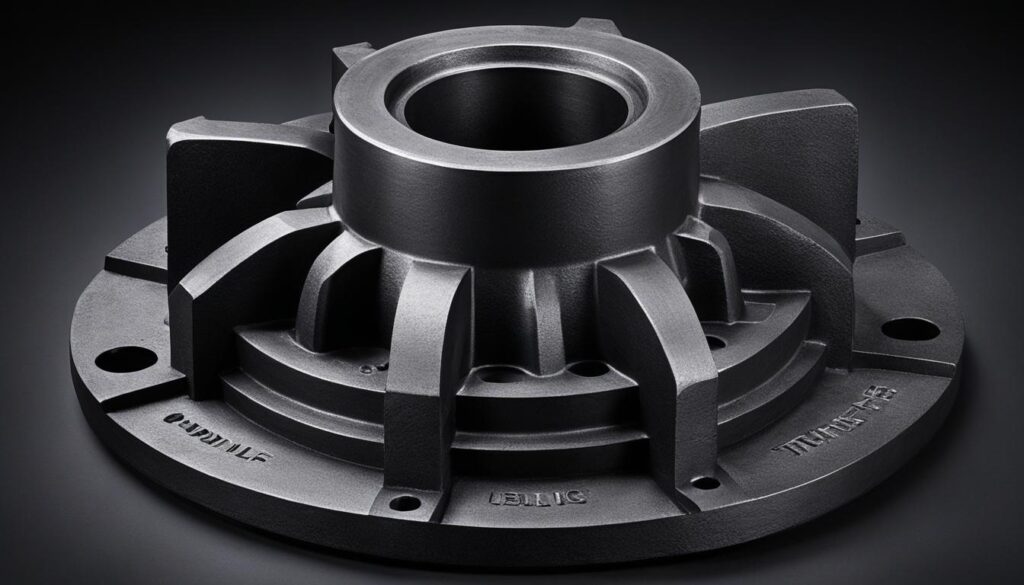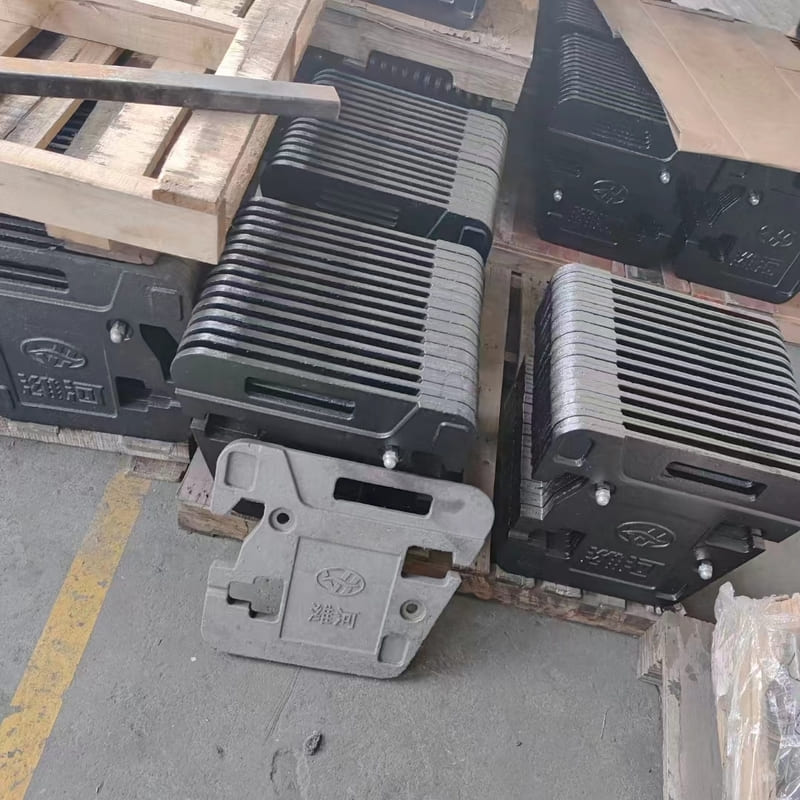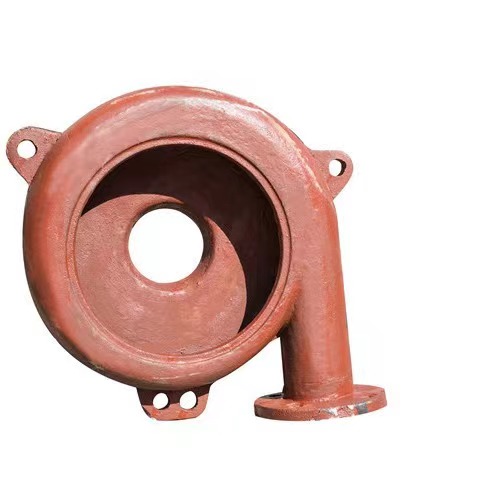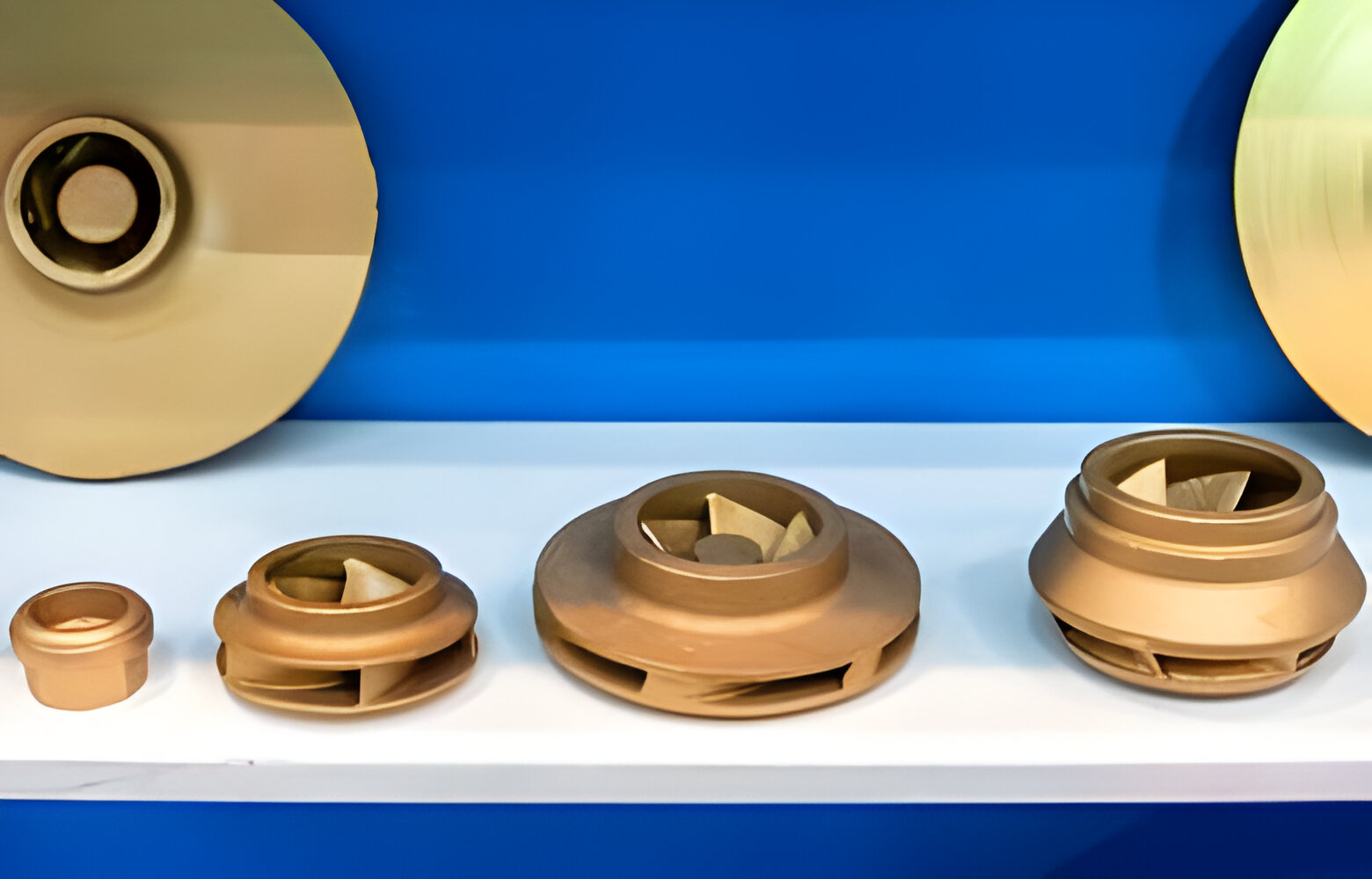As a leading manufacturer in the industry, KT-Foundry is dedicated to providing the highest quality ductile iron castings for a wide range of engineering applications. Tensile strength plays a key role in ensuring that these castings are not only reliable but also durable enough to withstand the demands of various industries. In this article, we will explore the concept of tensile strength, its importance in product performance, and the reasons why ductile iron is an ideal material choice for many applications.
Key Takeaways
- KT-Foundry is a leading provider of high-quality ductile iron castings for various engineering applications.
- Tensile strength is a crucial property determining the reliability and longevity of iron castings.
- Ductile iron is a superior material due to its ability to withstand significant stress before failing.
- Tensile strength affects product performance in a wide range of industrial and engineering applications.
- Understanding tensile strength and material properties is essential for selecting the right materials for specific applications.
Introduction to Ductile Iron Castings and Their Applications
Ductile iron castings, a versatile cast iron material, have become a popular choice for various industrial uses and engineering solutions. This is because of their unique ability to provide high-strength iron components coupled with exceptional ductility. The combination of these characteristics sets them apart from other cast iron types and makes them a preferred option for several applications in infrastructure development.https://www.youtube.com/embed/1jMIyqkuloE
The journey of ductile iron as a material of choice began with the discovery of nodular graphite inclusions in cast iron during the 1940s. These inclusions transformed the brittle nature of traditional cast iron into a more ductile and resilient material. Over the years, improvements in the production process led to the development of high-quality ductile iron castings that outperform other cast iron grades in terms of strength and durability.
Companies like KT-Foundry have played a crucial role in revolutionizing the production of ductile iron castings. By employing state-of-the-art technology and strict quality control measures, they manage to produce material solutions that cater to a wide range of industries. Some of the key applications of KT-Foundry's ductile iron castings include:
- Automotive components
- Pipeline systems
- Machinery parts
- Building and infrastructure elements
Understanding the property requirements of specific engineering applications is essential to select the optimum material for the job. Ductile iron castings offer an ideal balance between strength, durability, and cost-effectiveness, making them an excellent choice for a variety of demanding applications across various industries.
The Science Behind Tensile Strength in Materials
In the engineering world, understanding a material's tensile strength is crucial for ensuring reliability and performance in a range of applications. In this section, we'll dive into the technical aspects of tensile strength and its significance for ductile iron castings. We'll also explore factors that influence tensile strength and how they can be controlled during production.

A close-up view of a machine clamping a thin strip of ductile iron casting, exerting tension until the metal breaks. Visible strain and stress lines in the metal, along with digital readings of the force being applied. The testing area should be well-lit and show precise equipment details.
Defining Tensile Strength
Tensile strength is the maximum stress that a material can withstand while being stretched or pulled before necking, where the material begins to fail due to deformation. Tensile testing is an essential part of material science, as it helps in quantifying the mechanical properties of various materials. One crucial tool for understanding material behavior under tensile loading is the stress-strain curve, which shows how materials respond to applied stress and strain.
Factors Influencing Tensile Strength
Several factors impact the tensile strength of ductile iron, including its composition, microstructure, and temperature. For instance, the presence of nodular graphite within ductile iron significantly enhances its tensile strength compared to traditional gray iron. Additionally, the material's microstructure analysis sheds light on how its mechanical properties, such as tensile strength, are affected by the spatial arrangement of its constituents.
Heat treatment is another factor that influences tensile strength in ductile iron castings. For example, annealing can promote a more ductile microstructure, while quenching and tempering can increase the material's ultimate tensile strength and yield strength. Such treatments play a crucial role in ensuring that ductile iron castings meet the demands of their intended applications, providing quality assurance in the process.
Lastly, the temperature at which ductile iron is used can also affect its tensile strength. As material behavior can change with temperature, it is essential to select a suitable material and treatment for the specific operating environment.
At KT-Foundry, we carefully manage these factors during the production of our ductile iron castings to optimize tensile strength and meet the stringent requirements of various industries. By understanding and controlling the factors that influence tensile strength, we provide high-quality ductile iron castings that excel in numerous applications.
Production Processes That Enhance the Strength of Ductile Iron Castings
At KT-Foundry, we focus on innovative foundry technology to create ductile iron castings that exhibit high tensile strength and longevity. Our production processes revolve around three main aspects: molten metal treatment, alloying components, and casting techniques.
Molten metal treatment involves the preparation, treatment, and control of molten iron. Using cutting-edge equipment and monitoring systems, we ensure that the molten metal reaches the optimal temperature and chemical composition prior to casting. In addition, we employ degassing techniques to eliminate unwanted gases and impurities, which can negatively impact the strength and quality of the castings.

Create an image of a furnace pouring molten iron into a ladle while a technician adds an alloying element to improve the ductility of the metal. Show the molten metal glowing hot and fluid as it flows into the ladle, with the technician carefully adding the alloying element to a glowing crucible nearby. Use contrasting colors to emphasize the heat and danger of the process, such as deep reds and oranges for the molten metal and bright blue or green for the alloying element.
Once the molten metal is ready, we add carefully-selected alloying components to enhance the overall mechanical properties of ductile iron castings. Through precise control over the composition and distribution of alloying elements, we improve the microstructure of the cast iron and ultimately, its tensile strength. Common alloying elements include:
- Carbon
- Silicon
- Manganese
- Phosphorus
- Sulfur
Lastly, our casting techniques play a vital role in the final product's strength. We utilize advanced mold design and pattern-making technologies to ensure that the molten iron flows evenly and accurately fills the mold cavities. This ensures a uniform distribution of material, which aids in achieving consistent tensile strength across the entire casting. Moreover, our cooling and solidification processes are optimized to minimize defects and stress concentrations, ultimately enhancing the overall performance of the cast iron components.
Quality control is an integral part of our production process. We have implemented stringent inspections and testing protocols at every stage of the manufacturing process to ensure consistent tensile strength in the final product. Our quality assurance measures include:
- Visual inspection of molds and castings
- Chemical analysis of the molten metal
- Dimensional inspection of the casting
- Mechanical testing to assess tensile strength
- Microstructure analysis to evaluate the presence of nodular graphite
By employing a comprehensive approach to production processes and quality control, we can effectively enhance the strength of ductile iron castings, making them a durable and reliable choice for a wide array of engineering applications.
Comparative Analysis of Ductile Iron Castings and Other Metals
In this section, we will compare the tensile strength of ductile iron castings to steel and explore the economic and weight advantages of ductile iron over competitive materials. Through an in-depth examination of metallurgical properties and industrial economics, we aim to demonstrate the value of ductile iron as a cost-effective and lighter-weight solution in various engineering applications.
Strength Comparison with Steel
Steel, as a widely used engineering material, is known for its superior strength and durability. However, ductile iron offers comparable performance in many applications. The key advantage of ductile iron comes from its strength-to-weight ratio, which allows for a balance of strength and weight efficiency, making it an attractive option in specific engineering scenarios.
Weight and Cost Efficiency in Different Metals
When comparing ductile iron with other materials like aluminum and traditional cast iron, it becomes evident that ductile iron holds economic and weight advantages. The table below illustrates the characteristics of ductile iron, steel, aluminum, and traditional cast iron, considering their respective strength-to-weight ratios and cost-effectiveness in industrial applications:
| Material | Strength-to-Weight Ratio | Estimated Cost |
|---|---|---|
| Ductile Iron | High | Low |
| Steel | Very High | High |
| Aluminum | Medium | Medium |
| Traditional Cast Iron | Low | Low |
As seen in the table above, ductile iron provides a high strength-to-weight ratio while maintaining a relatively low cost compared to materials like steel. This advantageous combination means that industry professionals are increasingly adopting ductile iron as a more cost-effective material for their projects.
In conclusion, the inherent properties of ductile iron make it a competitive material in numerous industries. With its economic advantages and lighter-weight solutions, ductile iron castings are continuously proving their worth in various engineering applications. At KT-Foundry, we pride ourselves on producing high-quality ductile iron components that meet our customers' performance and efficiency requirements.
Real-world Applications and Case Studies of Ductile Iron Castings
As a leading provider of high-quality ductile iron castings, KT-Foundry has a wealth of experience in the practical implementation of this versatile material across various industrial sectors. In this section, we showcase a selection of case studies that demonstrate the successful application of ductile iron castings in real-world situations. These examples reinforce the strength, durability, and industry standards that make ductile iron an ideal choice for infrastructure and engineering projects.
One of our clients, a leading water utility company, was seeking a cost-effective, robust, and sustainable solution to replace their aging water supply infrastructure. Our ductile iron castings met all their requirements, providing a highly durable, corrosion-resistant, and performance-driven solution. The utility company observed numerous benefits, including reduced maintenance costs, efficient water flow, decreased leakage, and an extended lifespan for their newly implemented infrastructure.
Case Study 2: Bridge Construction
A nation-wide bridge construction project sought a strong, lightweight, and malleable material for various components, such as support brackets, reinforcement bars, and fasteners. After evaluating several options, the project team decided to use our ductile iron castings due to their superior tensile strength, manufacturing flexibility, and compatibility with industry standards. The outcome was a durable infrastructure able to withstand heavy loads, environmental stress, and resist corrosion, ultimately reducing long-term maintenance costs and ensuring public safety.
Case Study 3: Industrial Machinery Manufacturing
For a leading industrial machinery manufacturer, downtime and frequent replacements of key components posed significant operational challenges. Our ductile iron castings provided a high-strength, wear-resistant solution for their manufacturing equipment, increasing overall efficiency and productivity. By implementing our castings in components such as gears, shafts, and bearings, the company achieved a marked reduction in maintenance, spare part inventory, and energy consumption, leading to significant cost savings and increased profit margins.
In each of these case studies, KT-Foundry's ductile iron castings not only showcased its practical strengths but also demonstrated its role in creating durable infrastructure and meeting stringent industry standards. By understanding the unique capabilities of ductile iron, organizations can make informed decisions that maximize efficiency, reduce costs, and enhance overall performance.
Improving Tensile Strength in Your Ductile Iron Castings
Enhancing the tensile strength of ductile iron castings requires careful attention to material selection, treatment processes, and design considerations. In this section, we will guide you through these crucial aspects, discussing the available options and design tools to help you achieve the desired strength and performance in your cast components.
Material Selection and Treatment
First and foremost, making an informed decision on the appropriate cast iron selection for your specific application relies on a thorough understanding of the various ductile iron grades and their properties. Additionally, treating the chosen ductile iron grade with tailored thermal treatments can lead to significant material enhancements. One popular treatment option offered at KT-Foundry is the austempering process, which incorporates a heat treatment regime designed to enhance the ductile iron's tensile strength, ductility, and wear resistance.
Design Considerations for Optimizing Strength
While material selection and treatment play significant roles in determining the tensile properties of cast components, so too do thoughtful structural design optimization choices. Careful consideration of casting design can influence stress distribution, directly affecting the tensile characteristics of the final part. Advanced design tools such as finite element analysis (FEA) allow engineers to predict and control stress distribution, optimizing performance in ductile iron cast components.
To illustrate the importance of design optimization, consider the following typical design enhancements for improving tensile strength:
- Uniform wall thickness: Achieving a consistent wall thickness in your cast components helps reduce the risk of stress concentrators and hot spots, which may lead to premature failure.
- Fillets and radii: Incorporating fillets and radii at corners and junctions can help reduce stress concentrations that could otherwise compromise part strength.
- Minimizing sudden geometry changes: Gradual transitions between different cast component sections can aid in evenly distributing stress across the cast part, promoting enhanced tensile performance.
By combining informed cast iron selection, suitable treatments, and thoughtful structural design optimization, you can significantly enhance the tensile strength of your ductile iron castings, ensuring lasting reliability and performance.
Conclusion
In conclusion, understanding the tensile strength of ductile iron castings is crucial in making a strategic material choice for various applications. By realizing the importance of tensile strength, professionals can ensure the materials used in their projects provide the necessary durability and reliability. As a leading foundry, KT-Foundry has demonstrated its commitment to leveraging industry advancements to produce high-tensile strength ductile iron solutions that exceed customer expectations.
Through advanced manufacturing processes, rigorous quality control, and innovative design optimization, KT-Foundry has set a new standard in the cast iron industry. Their commitment to quality has allowed them to provide superior ductile iron castings not only to the engineering sector but also to a wide range of other industries. The outstanding performance of KT-Foundry’s ductile iron products is a testament to the material's potential and its ability to stand up against competitive alternatives like steel and aluminum.
Looking ahead, the future of ductile iron castings in engineering and innovation seems promising. As more professionals recognize the distinct advantages of this versatile material, it is likely to continue playing a pivotal role in the development of new infrastructure and technology. Ultimately, KT-Foundry will remain at the forefront of these developments, leading the way in offering best-in-class ductile iron casting solutions with high tensile strength for industries worldwide.
FAQ
What is the difference between ductile iron and regular cast iron?
Ductile iron has a unique microstructure containing nodular graphite, which gives it superior tensile strength and ductility compared to regular cast iron. This makes it more suitable for demanding engineering and industrial applications, as it can withstand significant stress before failing.
What factors influence the tensile strength of ductile iron?
Factors influencing tensile strength include material composition, microstructure, temperature, and the heat treatment process. At KT-Foundry, these factors are controlled during the production process to optimize tensile strength in ductile iron castings.
How does the tensile strength of ductile iron compare to steel?
In terms of tensile strength, ductile iron can be very close to steel, depending on its grade and heat treatment. However, ductile iron offers additional advantages like cost-effectiveness and better strength-to-weight ratios, making it a preferred choice in certain applications.
How does KT-Foundry ensure consistent tensile strength in its ductile iron castings?
KT-Foundry employs foundry technology, molten metal treatment, alloying components, and strict quality control throughout the manufacturing process. This ensures that their ductile iron castings consistently meet the desired tensile strength.
What are some practical applications of ductile iron castings?
Ductile iron castings have a wide range of applications, including infrastructure development, automotive components, machinery parts, and pipe fittings. Their high tensile strength and durability make them a versatile choice for industrial and engineering solutions.
How can one improve the tensile strength of ductile iron castings?
Choosing the proper ductile iron grade and employing specific treatment options like austempering helps to improve the tensile strength of ductile iron castings. Additionally, design alterations and advanced design tools like finite element analysis can optimize the performance of ductile iron cast components for strength.






